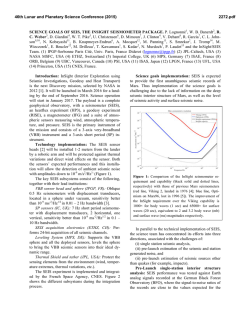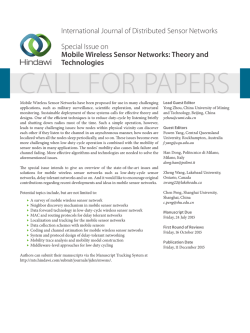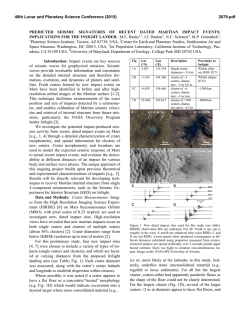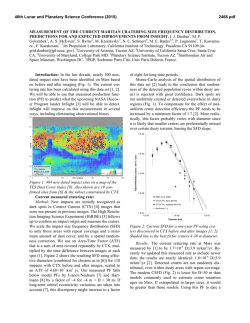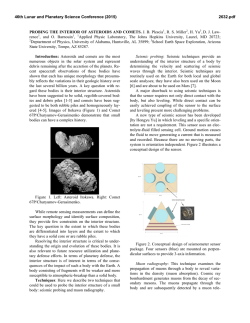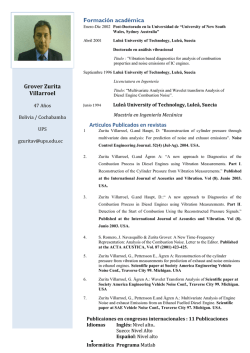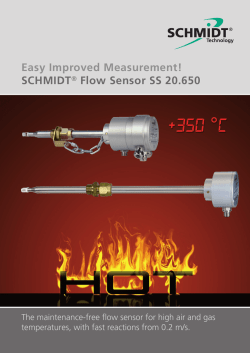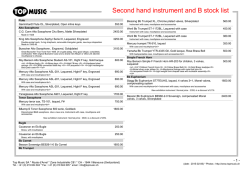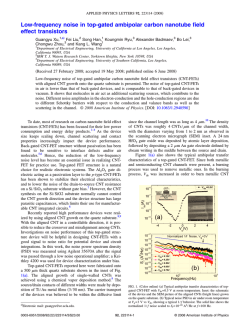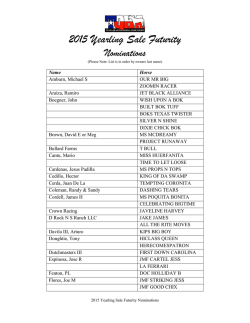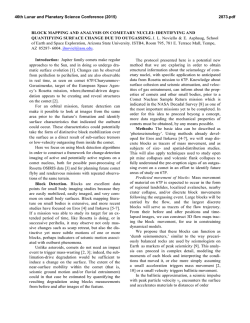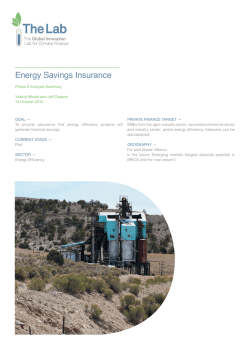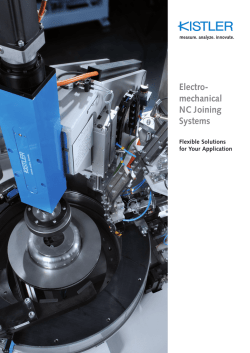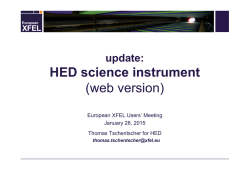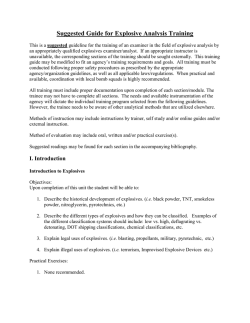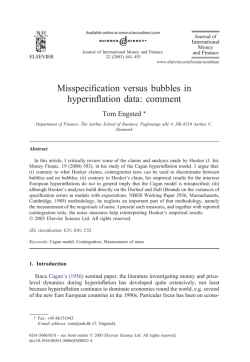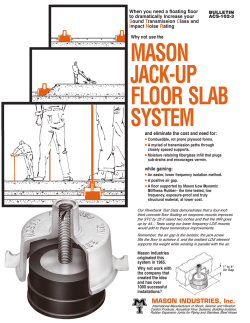
Performance and Noise modelling of the Short Period Seismometer
46th Lunar and Planetary Science Conference (2015) 2146.pdf Performance and Noise modelling of the Short Period Seismometer SEIS-SP, part of the SEIS instrument for NASA’s 2016 InSight Mission . N. E. Bowles1, W. T. Pike2 , N. Teanby3, G. Roberts6, S. B. Calcutt1, J. Hurley4, P. Coe1, J. 1 Wookey3, P. Dunton 4, I. Standley6, J. Temple1, R. Irshad4, J. Taylor3, T. Warren1 and C. Charalambous2, Atmospheric, Oceanic and Planetary Physics, University of Oxford, Clarendon Laboratory, Oxford, UK ([email protected]), 2 Department of Electrical and Electronic Engineering, Imperial College, London, UK. 3Department of Earth Sciences, University of Bristol, Bristol, UK, Centre for Nanoscience and Quantum Information, University of Bristol, Bristol, UK, 4RALSpace, Science and Technology Facilities Council Rutherford Appleton Laboratory, UK, 5Kinemetrics Inc. Pasadena CA, USA, 6 Department of Earth and Planetary Sciences, Birkbeck College, University of London, London, UK. Introduction: NASA’s InSight mission [1] is due to land on Mars in September 2016 with instrumentation designed to probe the interior structure of the planet. One of the main instruments included in the payload is the seismic instrumentation package SEIS [2]. SEIS is the critical instrument for delineating the deep interior structure of Mars, including the thickness and structure of the crust, the possible composition of the mantle, and will help to constrain the size of its core. The complete SEIS package includes the Very Broad Band (VBB) 3-axis sensor [2] covering the frequency range 0.005 to 1 Hz and the Short Period (SEIS-SP) instrument covering the frequency range 0.05 to 40 Hz. To couple the instrument to the Martian surface, SEIS will be deployed by the lander’s robot arm and then covered by a wind and thermal shield (WTS) to isolate it from the weather (Figure 1). SEIS itself includes aerogel thermal insulation, which combined with the WTS helps to mitigate the effects of wind and thermal fluctuations. WTS' Sensor' Assembly' Thermal' Blanket' Figure 1. Layout of the SEIS instrument package, showing the Wind and Thermal Shield (WTS), thermal blanket and complete SEIS sensor assembly. (Image: InSight SEIS team). SEIS-SP sensor description: The SEIS-SP sensor is an innovative micro-machined silicon device that is hermetically sealed (Figure 2, [3]).The sensor consists of a micromachined silicon suspension supporting a proof mass that moves laterally. The proof-mass position is sensed by a periodic linear capacitive array transducer allowing highly sensitive position detection combined with feedback control at multiple null points. Operation at any of these points enables the sensor to function over a large tilt range without compromising the noise performance. As well as the capacitive sensing elements, the proof mass has planar coils on the surface to electromagnetic actuator when placed in a static magnetic field. Each of the three sensor axes is packaged as a separate unit, and includes thick-film hybrid pre-amplifier electronics designed to operate over the full range of expected martian surface temperature conditions (e.g. 150 - 290 K). The anticipated noise floor of the flight device is 0.5 ng/√Hz in the 0.1 to 10Hz band. Figure 2. An integrated SEIS-SP sensor die, 25 x 25 mm. InSight poses some unique problems in data extraction not encountered in terrestrial seismology. Part of the challenge concerns the unknown nature of the planet’s seismic signal itself, including potential sources and transmission. But independent of the seismic analysis, perhaps the biggest challenge is isolating the seismic portion of the signal in the dataset returned to Earth. Terrestrial seismology sidesteps this problem by deploying instruments in vaults that considerably attenuate any aseismic contributions to the seismometer output. Figure 3a illustrates the signal paths for a terrestrial vault installation with a seismometer signal, x0 with temperature and pressure, x1 and x2, filtered through the vault and instrument transfer function, D0,1,2 and I0,1,2, which in general contain proportional, integral and differential terms. Ideally three entirely independent signal paths prevent crosstalk between the signals. In practice a deep vault will minimise any interaction between the three signals, even if the seismometer itself has finite temperature and pressure coefficients. For all the signal paths there is an inevitable contribution to each signal path from the instrument noise, n0,1,2. On Earth the seismometer has been designed such that this noise is below the weakest seismic signal expected. When taken altogether, the separation of the signal pathways enables the seismologist to concentrate immediately on the seismic analysis of the seismometer output. 46th Lunar and Planetary Science Conference (2015) Figure 3. Flow for SEIS-SP noise source modeling and characterization – see text for details. On Mars it is much more difficult to minimise the signal interactions (Figure 3b). InSight will be deploying SEIS on the surface, not in a vault, though there is some mitigation from the wind and thermal shield placed over SEIS. Nevertheless the cross terms in the deployment signal transfer function, Dij, cannot not be neglected as on Earth and the instrument cross terms in Iij, will mix the temperature and pressure signals with the seismic signal. Furthermore, the instrument noise contributions, n0,1,2, can no longer be guaranteed to be below the seismic signal. The resulting seismic channel output, z0, will therefore have substantial contributions from aseismic signals and the instrument noise that will need to be removed as far as possible before any seismic analysis. This work can therefore be regarded as trying to best estimate Dij and Iij through an understanding of the physical interactions that underlie these transfer functions. SEIS-SP Regolith Noise Transfer function Measurements: The transfer function between the WTS and the SEIS-SP sensor package was quantified in analogue environments, both in the laboratory in a 2m by 2m sandpit, and in basaltic desert environments at the Hverfjall Cinder cone apron, Iceland [4]. These experiments found that around 2% of the WTS generated seismic noise is transferred to the SEIS instruments at 5Hz. This is five times less than predicted by simple elastic theory and suggests anelastic regolith properties. These anelastic effects, which will affect vibrations transmitted from the spacecraft and other natural sources as well at the WTS, are being further quantified by the Bristol group and will be incorporated into the overall noise model. Determination of noise for the SP instrument: The components of the SP self-noise have been modelled in PSPICE as part of the instrument analysis and confirmed by coherency testing alongside high performance terrestrial seismometers in lowenvironmental-noise vaults (e.g. [5]) Determination of the environmental con- 2146.pdf tributions: Data from the Auxiliary Payload Sensor Subsystem (APSS) on the InSight lander provides measurements of the atmospheric pressure, temperature and wind speed as part of the mission’s continuous housekeeping. The primary role of the APSS is to determine when the environmental noise exceeds the SEIS noise requirement i.e. to flag potentially ‘bad’ data. The VBB team also intends to decouple the environmental background from the seismic signal also using the APSS data and a similar approach, which is described here. 1) For wind/pressure turbulence effects: We are developing empirical models and numerical simulations using testing in environmental chambers and applying finite-element model analyses across the frequency band of the SP sensors for a representative range of a) Background wind/pressure flows; b) Wind velocity fluctuations (using the Viking data as a baseline for a static lander) for both night and day conditions; and c) Pressure fluctuations (initially using data from Mars Pathfinder). 2) For temperature effects: In a similar way to the wind/pressure turbulence effects, we are developing models to map variations in the atmospheric and surface temperatures to measurements made by the SP. a) Initial numerical analysis will once again use Viking and Pathfinder data as example static landers with upto-date physical models of the SEIS instrument system. b) Laboratory measurements will use our existing lownoise cryo-test rig (built as part of the SP electronics qualification process) and flight-like SP hardware including sensors, feedback board electronics. Future work: The SEIS-SP flight sensor units are now in final production. Working closely with other members of the SEIS science and engineering teams, we will work to combine measurements of the instrument’s transfer function, regolith properties and environmental noise sources to generate a comprehensive instrument model. It is hoped that this model will help with the detailed analysis of the SEIS-SP instrument when it is installed on the surface of Mars in September 2016. Acknowledgements: The SEIS-SP team would like thank the UK Space Agency for funding the development and testing of the SEIS-SP sensor. The assistance and support of the InSight mission team around the world and the SEIS instrument team in particular is gratefully acknowledged. References: [1] Banerdt, W. B. et al. (2013) LPSC XXXXIII Abstract #1915. [2] Mimoun D. H. et al. (2012), LPSC XXXXIII, abstract #1493. [3] Pike, W.T. et al.(2014) Proc. IEEE SENSORS, 1599 – 1602. [4] Teanby, N. A. et al. (2013) , LPSC XXXXIV, abstract #1035. [5] http://www.bristol.ac.uk/nsqi-centre/
© Copyright 2025
